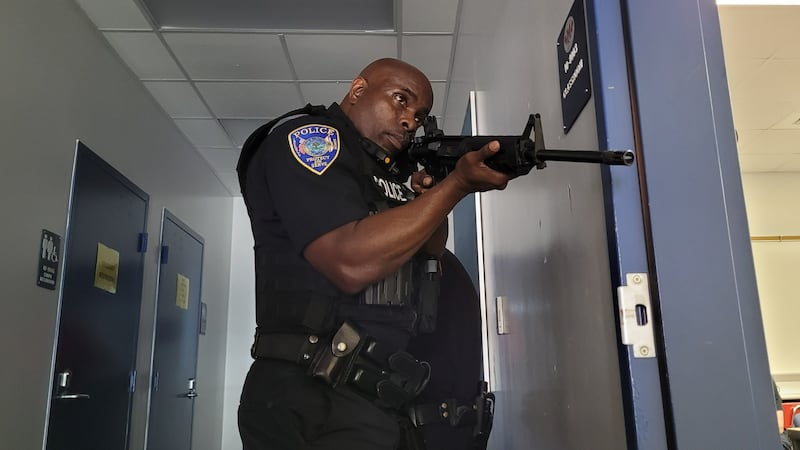The Relevance of Active Shooter Training in High-Risk Settings
The Relevance of Active Shooter Training in High-Risk Settings
Blog Article
Discovering the Trick Parts and Purposes of Reliable Active Shooter Training Programs
Active shooter training programs are critical in gearing up people and organizations with the required skills to react successfully to potential threats. As we explore the complexities of these training programs, it becomes apparent that understanding their extensive nature is important to improving safety measures and response capacities.
Value of Energetic Shooter Training
Energetic shooter training programs are crucial for improving readiness and response despite possible hazards. These programs aim to outfit individuals, companies, and areas with the knowledge and skills required to properly reply to energetic shooter situations. The increasing frequency and seriousness of such cases underscore the significance of positive steps, as prompt and informed responses can significantly reduce injury.

Additionally, these programs can aid alleviate the anxiousness and anxiety that usually accompany conversations regarding possible hazards. By giving organized support and practical methods, people get self-confidence in their capability to respond suitably. Ultimately, the importance of active shooter training lies in its possible to conserve lives, minimize injuries, and grow a ready and resilient community qualified of facing unanticipated challenges.
Key Components of Training Programs
Effective energetic shooter training programs usually integrate a number of essential parts developed to prepare individuals for real-world scenarios. The first element is detailed education and learning on the nature of energetic shooter events, including statistics, study, and emotional factors that affect aggressors. This theoretical structure is important for fostering recognition and understanding amongst individuals.
Following, programs commonly include training on individual safety procedures, stressing the "Run, Hide, Battle" method. Individuals learn just how to examine their atmosphere, make quick choices, and take proper actions during a situation. Furthermore, the incorporation of effective interaction abilities is vital, as individuals should comprehend exactly how to report incidents and share essential info with police.
Another essential part is the involvement of regulation enforcement or safety experts, that provide insights right into tactical responses and the value of cooperation throughout a crisis. Moreover, programs must deal with the psychological consequences of an energetic shooter situation, supplying techniques for coping and recuperation.
Lastly, ongoing training and refresher course programs are essential to guarantee that knowledge stays existing and individuals really feel positive in their abilities. With each other, these essential parts create a well-rounded training program that gears up people to respond properly to an active shooter occasion.
Realistic Circumstance Simulations
Reasonable circumstance simulations are a critical facet of active shooter training programs, giving individuals with the opportunity to involve in hands-on technique that mirrors prospective real-life scenarios. These simulations improve the training experience by developing an immersive atmosphere where people can apply theoretical understanding in functional setups.
With the use of role-playing, mock circumstances, and specialized training facilities, participants experience the prompt challenges and stressors associated with an active shooter occurrence. This technique of training promotes quick decision-making, synergy, and the application of security methods under stress. It allows -responders to create vital skills such as situational understanding, threat analysis, and efficient evacuation treatments.
Moreover, sensible simulations aid to determine possible weaknesses in individuals' feedbacks, making it possible for instructors to supply targeted feedback and improve general preparedness. The incorporation of varying situations, including various areas and attacker accounts, additionally enriches the training experience, ensuring that participants are fully equipped to manage a series of potential circumstances.
Inevitably, these simulations offer not just to advise yet additionally to build confidence among individuals, fostering a feeling of preparedness that is crucial for effective emergency situation action in the face of an active shooter threat. active shooter training.
Interaction Techniques in Training
Clear interaction is important in energetic shooter training programs, as it directly affects the effectiveness of action efforts during a crisis. Training individuals need to comprehend the methods and Get More Info procedures that will guide their actions if faced with an energetic shooter situation. Developing official website clear lines of communication makes certain that all people entailed can pass on information without delay and accurately.

Furthermore, training programs should highlight the significance of active listening. Inevitably, efficient interaction techniques are crucial for preparing individuals to react decisively and cohesively in the face of an active shooter event.
Psychological Readiness Strategies
Psychological readiness techniques are significantly acknowledged as necessary components of active shooter training programs. These techniques aim to equip individuals with the psychological durability required to react successfully in high-stress scenarios. By cultivating a mindset in harmony with possible threats, participants can better take care of fear, stress and anxiety, and complication throughout vital incidents.
Key psychological readiness techniques consist of scenario-based training and anxiety shot workouts. Scenario-based training submerses participants in reasonable simulations that imitate the disorder of an energetic shooter event, allowing them to practice decision-making under stress. This direct exposure aids develop familiarity with emergency situation procedures, boosting natural actions.
Tension shot involves gradual exposure to stress-inducing scenarios, allowing individuals to create like it coping systems. This can include breathing workouts, visualization techniques, and cognitive restructuring to reframe adverse thoughts. By integrating these strategies, training programs can cultivate a feeling of confidence and control, which is vital in crisis circumstances.
Moreover, post-incident emotional support is vital to deal with the emotional consequences of an energetic shooter event. Incorporating mental health resources into training programs not only prepares people for instant feedbacks however also promotes lasting emotional well-being, eventually adding to a more secure and much more durable setting.
Verdict

Report this page